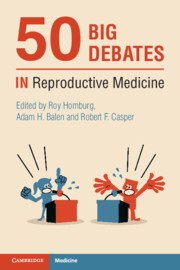Book contents
- 50 Big Debates in Reproductive Medicine
- Series page
- 50 Big Debates in Reproductive Medicine
- Copyright page
- Contents
- Contributors
- Foreword
- Introduction
- Section I Limits for IVF
- Section II IVF Add-ons
- 5A DHEA Is an Effective Treatment for Poor Responders
- 5B DHEA Is an Effective Treatment for Poor Responders
- 6A The Addition of LH/hCG to FSH Improves IVF Outcome
- 6B The Addition of LH/hCG to FSH Improves IVF Outcome
- 7A Acupuncture Is a Useful Adjuvant for Fertility Treatment
- 7B Acupuncture Is a Useful Adjuvant for Fertility Treatment
- 8A There Is a Role for Pre-conceptional Treatment with CoQ10
- 8B There Is a Role for Pre-conceptional Treatment with CoQ10
- 9A There Is a Role for Pre-conceptional Treatment with Vitamin D
- 9B There Is a Role for Pre-conception Treatment with Vitamin D
- 10A Natural Killer Cell Assay in the Blood Is a Useless Investigation
- 10B Natural Killer Cell Assay in the Blood Is a Useless Investigation
- 11A Intralipid Therapy Has a Place in Infertility Treatment
- 11B Intralipid Therapy Has a Place in Infertility Treatment
- 12A The Endometrial Scratch Has Had Its Day
- 12B The Endometrial Scratch Has Had Its Day
- 13A Corticosteroid Therapy Is Useful in Assisting Implantation
- 13B Corticosteroid Therapy Is Useful in Assisting Implantation
- Section III The Best Policy
- Section IV Embryology
- Section V Ethics and Statistics
- Section VI Male-factor Infertility
- Section VII Genetics
- Section VIII Ovarian Stimulation
- Section IX Hormones and the Environment
- Index
- References
6A - The Addition of LH/hCG to FSH Improves IVF Outcome
For
from Section II - IVF Add-ons
Published online by Cambridge University Press: 25 November 2021
- 50 Big Debates in Reproductive Medicine
- Series page
- 50 Big Debates in Reproductive Medicine
- Copyright page
- Contents
- Contributors
- Foreword
- Introduction
- Section I Limits for IVF
- Section II IVF Add-ons
- 5A DHEA Is an Effective Treatment for Poor Responders
- 5B DHEA Is an Effective Treatment for Poor Responders
- 6A The Addition of LH/hCG to FSH Improves IVF Outcome
- 6B The Addition of LH/hCG to FSH Improves IVF Outcome
- 7A Acupuncture Is a Useful Adjuvant for Fertility Treatment
- 7B Acupuncture Is a Useful Adjuvant for Fertility Treatment
- 8A There Is a Role for Pre-conceptional Treatment with CoQ10
- 8B There Is a Role for Pre-conceptional Treatment with CoQ10
- 9A There Is a Role for Pre-conceptional Treatment with Vitamin D
- 9B There Is a Role for Pre-conception Treatment with Vitamin D
- 10A Natural Killer Cell Assay in the Blood Is a Useless Investigation
- 10B Natural Killer Cell Assay in the Blood Is a Useless Investigation
- 11A Intralipid Therapy Has a Place in Infertility Treatment
- 11B Intralipid Therapy Has a Place in Infertility Treatment
- 12A The Endometrial Scratch Has Had Its Day
- 12B The Endometrial Scratch Has Had Its Day
- 13A Corticosteroid Therapy Is Useful in Assisting Implantation
- 13B Corticosteroid Therapy Is Useful in Assisting Implantation
- Section III The Best Policy
- Section IV Embryology
- Section V Ethics and Statistics
- Section VI Male-factor Infertility
- Section VII Genetics
- Section VIII Ovarian Stimulation
- Section IX Hormones and the Environment
- Index
- References
Summary
During the natural menstrual cycle both FSH and LH play important roles in the follicular phase, securing follicular growth and development resulting in competent oocytes capable of sustaining further development. It is well known that after an initial FSH rise in the early follicular phase, FSH becomes down-regulated in the middle of the follicular phase, while the concentration of LH remains relatively constant throughout the follicular phase. Selection of the dominant follicle takes place around the mid-follicular phase at a diameter of 8-10 millimetre. The selected follicle starts to develop LH receptors on the granulosa cells, while FSH receptor expression continues to decline until ovulation [1,2]. Thus, in the second half of the follicular phase both gonadotropins advance follicular growth with a key contribution from LH. In connection with ovarian stimulation (OS) and ART treatment, most protocols use either a GnRH-agonist or a GnRH-antagonist to secure low pituitary output of gonadotropins, especially LH. Therefore, OS protocols don’t mimic normal physiology and usually provide supraphysiological concentrations of FSH, while LH/hCG typically is considerably lower than physiological concentrations. Thus, what are requirements of LH/hCG and should a lower threshold concentration be surpassed or preferentially be in the physiological range to improve IVF outcome? Many different meta-analyses have compared the use of HMG and FSH for OS to answer this question, but depending on inclusion criteria different results have been obtained – one favouring one conclusion over the other, while the opposite conclusion remains a valid option.
- Type
- Chapter
- Information
- 50 Big Debates in Reproductive Medicine , pp. 29 - 31Publisher: Cambridge University PressPrint publication year: 2021



